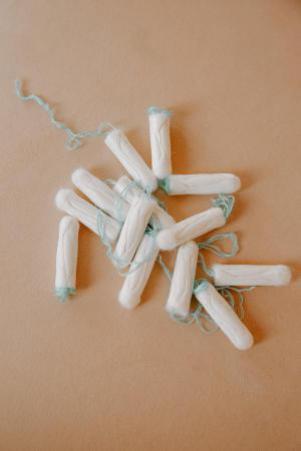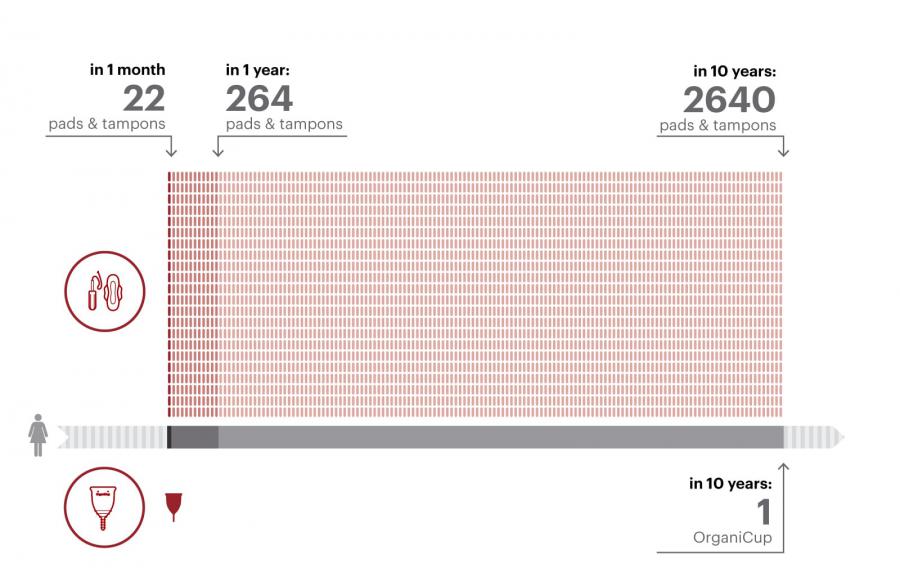Published on April 22, 2020
Let’s talk about a subject that a lot of the population deals with but not a lot of people talk about: menstrual products. The subject is not talked about often, and that has contributed to the lack of knowledge being shared about the tremendous impact disposable menstrual products have on the environment. Additionally, some people also dispose of these disposable menstrual products incorrectly by flushing them down the toilet, which can lead to clogs in the sewer system. It’s time to talk about some healthy, environmentally friendly menstrual alternatives.
The average menstruating individual uses approximately 11,000 disposable hygiene products, like tampons or pads, in a lifetime. This contributes to 12 billion pads and 7 million tampons going into the landfills annually1 (not to mention the total impact of producing, shipping, and packaging these products). These products are readily accessible and available to most people, yet many are unaware of the risky ingredients these products contain and what happens to them once they’re tossed out.

In the US, the Food and Drug Administration classes menstrual products as medical devices, not personal care products. This subconsciously allows people to believe that disposables are not only the most convenient option, but also have no health risk. Light reading material in the bathroom has made us aware of TSS (Toxic Shock Syndrome), but did you know that there are other dangers to disposable menstrual products use? Check out this article for a detailed list. Don’t forget, because the FDA classifies them as medical devices, companies aren’t required to disclose what’s in them.
The plastic problem
Let’s talk about plastic for a moment. Most people are aware of the dangers of plastic and its negative environmental impact. Most of us are willing to skip the plastic bag at the grocery store, but did you know that a package of sanitary pads can contain the equivalent of about four plastic bags? Because plastic doesn’t biodegrade, it’ll take at least 500-800 years for each pad and tampon to decompose. Remember, Tampon applicators are NOT recyclable! A recent report by the European Commission concluded that disposable menstrual products are the fifth most common type of waste washing up on beaches2. Microplastics are a subject all on their own, so to find out more info on them, check this article out.
Landfill or treatment plant
Manufacturing disposable hygiene products generates a total carbon footprint of about 15 million tons of greenhouse gas emissions annually, according to the United Nations Environment Program3. That’s the equivalent of burning about 35 million barrels of oil. After using pads or Tampons, users either flush them or throw them away. Regardless of how they are disposed, these products still have negative impacts on the environment long after they leave your home. If they don’t end up at the landfill, they end up being flushed. Anyone who has stepped foot near a bar screen at a wastewater treatment plant knows this to be unsettlingly true. For those who don’t know, a bar screen is like a big strainer at the beginning of the wastewater treatment process that catches solids and removes them so the remaining liquid can be treated. These solids (menstrual products, “flushable” wipes, condoms, etc.) that some people tend to flush down the toilet wreak havoc on the treatment plant system. Because none of these products are biodegradable, they do not break down or disintegrate, so they can create clogs in the sewer system. You may think “out of sight, out of mind” when you flush something down the toilet, but please know that things do not magically disappear when you flush them. They still exist in the sewer system.

So what are some reusable products and why are they beneficial?
One of the many benefits of reusable products is it reduces waste compared to disposable products is. Cloth pads and underwear are made from mostly natural fibers and will biodegrade quite easily once they are thrown out. It may seem like more cost upfront, but alternatives can save you thousands in the long run.
Here’s a list of solutions to replace single-use, disposable menstrual products:
-
There are reusable pads that work just like disposable pads but are washable and reusable! They are made of cloth, not plastic! Cloth pads offer the opportunity to support local artisans. Here are the top 5 cloth menstrual pad brands.
-
There is absorbent underwear, which is designed to absorb menstrual flow on light or medium days (or can be used as a backup method). This underwear can be worn as regular underwear too! They are designed in triple layers of fabric.
-
There are menstrual cups made of medical-grade silicone that are inserted into the vagina and are meant to collect (not absorb) without any health hazards. These can be reused for up to 10 years! Put A Cup in it has a great quiz to help you find the perfect cup for your body, age, history, activity level, and more. The site also offers a great list of FAQs. The menstrual cup is super easy to clean…just wash with soap and water.
-
There are even reusable tampon applicators now!

For those of you in the back who still may not have heard, here are the top reasons why switching to a reusable menstrual product is a smart idea:
- There are multiple options to choose from that are not disposable products.
- They are really easy to clean.
- Saves YOU money in the long run!
- They’re safer for your body because “disposable” doesn’t mean “sterile.”
- Increased comfort.
- Environmentally friendly.
- Convenience. Most cup wearers say that they only have to empty their cup every 7-8 hours.
With over 50% of the world’s population menstruating, why has there been little to no innovations for over 80 years4? There is an urgent need to innovate and find sustainable yet practical solutions to menstrual hygiene challenges. Every period has an environmental impact…what’s yours?
1. Team OrganiCup, “Powerful Environmental Reasons To Switch To A Menstrual,” OrganiCup, April 20, 2018, https://www.organicup.com/blog/powerful-environmental-reasons-to-switch-to-a-menstrual-cup/
2. European Commission, Reducing Marine Litter: action on single use plastics and fishing gear, 11, https://ec.europa.eu/environment/circular-economy/pdf/single-use_plastics_impact_assessment.pdf
3. Janet Salem, “Meet the Samoan Businesswoman Who’s Making Sanitary Products More Sustainable,” UN Environment, June 3, 2018, https://www.unenvironment.org/news-and-stories/story/meet-samoan-businesswoman-whos-making-sanitary-products-more-sustainable
4. Donna Fuscaldo, “Meet the Entrepreneurs Disrupting the Feminine Care Industry,” Fortune, March 30, 2016, http://fortune.com/2016/03/30/5-period-startups/.